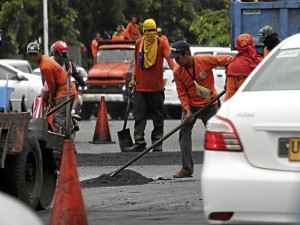Economists: Gov’t must speed up projects to boost growth

SLOW-MOVING. The absence of election-related spending may have contributed to a disappointing economic growth in the second quarter compared with last year, but economists agree that government’s sluggish spending in the first two quarters must be reversed in order to boost the economy in the remaining quarters.
Local economists on Wednesday expressed surprise over the disappointing GDP figure of 3.4 percent posted for the April-June period. The Philippine economy in the first semester also posted a slower 4 percent growth as weakness in construction and industry offset the rise in consumer spending amid a lackluster global recovery.
The economists all noted the absence this year of election-related spending and a global economic recovery that propelled the country in the second quarter of 2010.
But one point that both public and private economists agreed on was this: The government has to move public programs and projects faster.
“The aspirational growth target of 7 to 8 percent this year is now unattainable,” said Benjamin E. Diokno, UP professor and a former budget secretary.
GDP growth in the April-June period was below the government forecast of 4.5 to 5.5 percent, National Statistical Coordination Board secretary general Romulo A. Virola said in a briefing Wednesday.
Article continues after this advertisementIt was also less than half the figure of 8.9 percent reported in the second quarter of 2010 when the national elections were conducted, and the revised 4.6 percent GDP growth reported in the first quarter of 2011.
Article continues after this advertisementAccording to Malacañang, it is doing its best to perk up the economy by stepping up spending.
In July, a total of P133.45 billion had already been disbursed, “the highest national government spending figure so far this year,” said presidential spokesman Edwin Lacierda.
“Despite the gain we have made over the past year, we remain aware of the necessary steps we must take to achieve even more growth,” Lacierda said. “We are working to bring in more foreign direct investments, as evidenced by the President’s visit to China.”
Also, some P240 billion in government spending has been programmed for the second half of 2011, Socioeconomic Planning Secretary Cayetano W. Paderanga Jr. said.
According to Lacierda, the low growth rate was “not completely reflective of how the Filipino people are living,” and pointed to the fact that agriculture, for instance, grew by 7.1 percent in the second quarter, which implied that “the growth, while lower, has been equitable.”
Growth in agriculture was brought about by good sugarcane, rice and corn harvests.
Also, Paderanga said that the economy’s “prospects for the second half of 2011 are better than the first half’s performance.”
The boost, Paderanga explained, would come from continued strong rice production, real estate construction and growth in mining.—With a report from AP